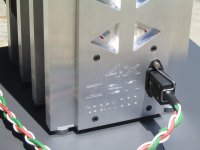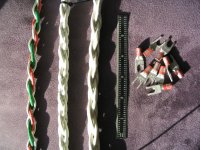I'm getting ready to build some speaker cables using CAT5e wire. I plan to use 3 CAT5 cables braided together. That should make sufficient gauge. What I wonder about is the need for proper termination to prevent ultra-sonic ringing (and associated catastrophic failure of amp) due to capacitance of the cables. I found a reference to proper termination in an article: Speaker Cables Science or Snake Oil Article by Pass; found near bottom of page at this link:
Technical Papers
Matt Polk used .047 uF cap and 6 ohm R in series placed across the speaker terminals; Nelson Pass used .1 uF cap and 5 ohm R.
I know little about electronics. Should I add this termination to the CAT5 cables? What do you experts think?
Thanks, Jim
Technical Papers
Matt Polk used .047 uF cap and 6 ohm R in series placed across the speaker terminals; Nelson Pass used .1 uF cap and 5 ohm R.
I know little about electronics. Should I add this termination to the CAT5 cables? What do you experts think?
Thanks, Jim
Thanks. I thought that in the paper they added the zobel (if that's the right name) across the speaker terminals to damp out the reflected energy and prevent ultra sonic oscillation. Are you saying that I should put something at the amp end as well? And is this important for tube amps as well as the SS? (I have only heard of problems with SS, but that may be due to the dominance of SS in the market place.)
Thanks, Jim
Thanks, Jim
Last edited:
I'm no expert (on this), but why don't you try it without the 'damper network' before deciding? The way I read 'the problem' is it applies only to some very high bandwidth output stages?
Have you thought of braiding four CAT5 cables together instead of three? I think it looks better....
Have you thought of braiding four CAT5 cables together instead of three? I think it looks better....
Banned
Joined 2002
I'm no expert (on this), but why don't you try it without the 'damper network' before deciding? The way I read 'the problem' is it applies only to some very high bandwidth output stages?
Have you thought of braiding four CAT5 cables together instead of three? I think it looks better....
How do you braid 4 ?
An externally hosted image should be here but it was not working when we last tested it.
An externally hosted image should be here but it was not working when we last tested it.
Jim,
Start out by trying a single pair... you might be surprised.
I just swapped out my single strand Cat 5 cables (dog chewed need repair), for a set of red & white ones Jason sent me to try out (as above).
The connectors are nice (althou 3/4" spaced doubles would not be a hardship), they are breaking in now (in other words i'll let them sit in the system for a while (and fix my known cables) before any serious compares.
dave
Start out by trying a single pair... you might be surprised.
I just swapped out my single strand Cat 5 cables (dog chewed need repair), for a set of red & white ones Jason sent me to try out (as above).
The connectors are nice (althou 3/4" spaced doubles would not be a hardship), they are breaking in now (in other words i'll let them sit in the system for a while (and fix my known cables) before any serious compares.
dave
Banned
Joined 2002
Jim,
Start out by trying a single pair... you might be surprised.
I just swapped out my single strand Cat 5 cables (dog chewed need repair), for a set of red & white ones Jason sent me to try out (as above).
The connectors are nice (althou 3/4" spaced doubles would not be a hardship), they are breaking in now (in other words i'll let them sit in the system for a while (and fix my known cables) before any serious compares.
dave
BTW U got mail.!
BTW that's orange and white
Banned
Joined 2002
Not the best pic and not the best 4-wire braid as the wires weren't all the same gauge, but it gives you the idea.
I will be braiding two white, one blue, and one red CAT5-type for my speaker cables (some day) which gives 12AWG.
cool, looks christmas'Y.
What kind of ends are you thinking about going and using ? Mostly everything on the market now a day's uses a heavy massed connector or something with lots of weight etc etc.
Banned
Joined 2002
Why not just use something that isn't prone to blowing your amp up and is much easier to make?
how is it going to blow up your amp ? only way i see it is if you cross your cables
Now you made me get out of my chair!
I found these beefy (nickel?) plated copper 1/4 inch ring terminals (which I modified into spades) at a surplus shop (Excess Solutions in Milpitas) for 20 cents each.
But in the past I have used these Vampire spades which are fairly minimalistic:
Vampire 1/4 inch spades
Attached pic also shows the white CAT3 (also 4 pairs of solid 24AWG like most CAT5) cable (someone gave me a huge roll) in a loose and tight braid.
I found these beefy (nickel?) plated copper 1/4 inch ring terminals (which I modified into spades) at a surplus shop (Excess Solutions in Milpitas) for 20 cents each.
But in the past I have used these Vampire spades which are fairly minimalistic:
Vampire 1/4 inch spades
Attached pic also shows the white CAT3 (also 4 pairs of solid 24AWG like most CAT5) cable (someone gave me a huge roll) in a loose and tight braid.
Attachments
Banned
Joined 2002
Now you made me get out of my chair!
I found these beefy (nickel?) plated copper 1/4 inch ring terminals (which I modified into spades) at a surplus shop (Excess Solutions in Milpitas) for 20 cents each.
But in the past I have used these Vampire spades which are fairly minimalistic:
Vampire 1/4 inch spades
Attached pic also shows the white CAT3 (also 4 pairs of solid 24AWG like most CAT5) cable (someone gave me a huge roll) in a loose and tight braid.
U should look at these,
An externally hosted image should be here but it was not working when we last tested it.
My interest in making speaker cables from CAT5 comes from seeing & hearing MJK's tube amp using home made cables using three braided CAT5's. It seemed like three would be tough enough to handle. And capacitance is additive in parallel--which is exactly what is going on here. Then there are the reports of these high capacitance cables blowing up some amps. Now my classic SS receivers from the early to mid 1970's may be more limited in band width than the fancy amps that got smoked, but I don't want to do something stupid and kill an amp.
AMPs that I might use these cables with include:
--Sansui 350A (from about 1972)
--Sansui 4000 (from about 1972)
--Yamaha CR-1000 (from about 1977)
-- Sonic Impact T-amp, gen 2
--MiniWatt tube amp
I ask because I would rather spend time learning, rather than learning by spending money to correct a disaster.
Thanks, Jim
AMPs that I might use these cables with include:
--Sansui 350A (from about 1972)
--Sansui 4000 (from about 1972)
--Yamaha CR-1000 (from about 1977)
-- Sonic Impact T-amp, gen 2
--MiniWatt tube amp
I ask because I would rather spend time learning, rather than learning by spending money to correct a disaster.
Thanks, Jim
Just buy a roll of 16 awg zip cord and be done with it.
It you want to be tweakie, get the white "outdoor patio" 16/3 extension cord from Walmart. Cut the lengths you need, braid two of the conductors together and use these on the negative terminals, use the remianing conductor on the positives.
Read 6Moons if you don't believe.
It you want to be tweakie, get the white "outdoor patio" 16/3 extension cord from Walmart. Cut the lengths you need, braid two of the conductors together and use these on the negative terminals, use the remianing conductor on the positives.
Read 6Moons if you don't believe.
Banned
Joined 2002
Just buy a roll of 16 awg zip cord and be done with it.
It you want to be tweakie, get the white "outdoor patio" 16/3 extension cord from Walmart. Cut the lengths you need, braid two of the conductors together and use these on the negative terminals, use the remianing conductor on the positives.
Read 6Moons if you don't believe.
thats a really good idea, LIKE WOW why didn't all of us think of that, ?
what a great idea, where have you been all these years!
thats a really good idea, LIKE WOW why didn't all of us think of that, ?
what a great idea, where have you been all these years!
He's been out listening to his speakers, not sitting around braiding wire and comparing copper to other copper.
Just buy a roll of 16 awg zip cord and be done with it.
16 awg zip cord is exactly what I have been using for years. The reason for wanting to change is that Martin (MJK) brought over his tube amp to try on a couple of my speaker builds and brought along some cables he made using three lengths of CAT5 braided together. While the differences between the zip cord and the CAT5 were not overwhelming, they were significant (persistent and repeatable.) I won't spend many hundreds of $$ chasing this, but am willing to drop $50 for a 500' spool of CAT5, plus some spade lugs and banana plugs, and invest my time.
My concern is with the zobel termination so I don't kill an amp in the learning process.
Thanks for all the comments,
Jim
- Status
- This old topic is closed. If you want to reopen this topic, contact a moderator using the "Report Post" button.
- Home
- Amplifiers
- Solid State
- DIY speaker cable question

